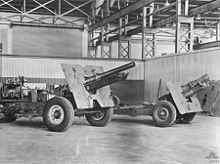Ordnance QF 25-pounder Short
It was used by several Royal Australian Artillery regiments during fighting in the South West Pacific Area, before being declared obsolete in 1946.
The development of the Ordnance QF 25-pounder Short was an important achievement for Australia's defence industry, and provided the Army with a weapon suited to conditions in the South West Pacific.
[7] The 25-pounder was well suited to the open conditions the Army experienced in the Mediterranean and Middle East theatres but proved difficult to deploy in jungle terrain.
[9] The difficulty of deploying artillery in New Guinea led to a need for a gun which could be broken down into light parts and transported by aircraft or jeeps.
[10] In September 1942, the Army's Director of Artillery, Brigadier John O'Brien, suggested that a variant of the 25-pounder be developed to meet this requirement.
[9] This proposal was approved, and all development work was conducted in Australia by the Army, the Ordnance Production Directorate and Charles Ruwolt Pty Ltd.[5] O'Brien produced the early design diagrams himself.
[11] The three organisations cooperated closely as they were strongly motivated to provide the Army with a useful light artillery piece as quickly as possible.
[15] Modifications included shortening the gun's barrel and recuperator, making the trail lighter, fitting smaller wheels, replacing the platform which allowed the gun to be rotated with a large spade and incorporating the new recoil system which had been developed to allow 25-pounders to be mounted in the Australian-designed Sentinel tank.
This range could be extended to 11,500 yards (10,500 m) if a super charge was used, though standing instructions warned against doing so except in emergencies due to the strain they placed on the gun carriage.
[5] The gun could fire the same variety of ammunition as the standard 25-pounder; namely high explosive, armour piercing, smoke, gas, propaganda and illumination shells.
[17] As completed, the gun's full designation was Ordnance QF 25-pounder Short (Aust) Mark I, but it was nicknamed the 'snort' by Australian soldiers.
It had a different recoil system to the Australian guns to allow super charge to be used, and was designated the Ordnance QF 25-pounder Mark IV.
[18] QF 25-pounder Short guns were first issued to front line artillery regiments in August 1943 as part of the reorganisation of the Australian Army's fighting units to the "Jungle division" structure.
The 9th Division's staff officers regarded the weapon as a success, as it could be readily transported on small vehicles, boats and sledges.
[27] During the Battle of Pearl Ridge in Bougainville a battery of eight 25-pounder Shorts from the 4th Field Regiment supported the advice until the infantry advanced beyond the range of these guns.
The gun also had a tendency to tilt at low elevation; this was remedied by its crew standing on the trails, an expedient that had previously been used with the QF 4.5 inch Howitzer.
[23] Concerns were also raised over the quality of workmanship, and the commander of the 2/4th Field Regiment rejected a batch of Short 25-pounders sent to his unit before the Nadzab operation in the belief that they had been poorly manufactured.
[14] Similarly, Australian historian Adrian Threlfall noted the shortcomings of the gun, but stated that its rapid development and introduction into service provides an example of the Army's success in adapting to the demands of jungle warfare.
[11] British historian Chris Henry has written that the QF 25-pounder Short "gave good service, and was robust enough to survive life in the jungle even though many modifications were needed".


